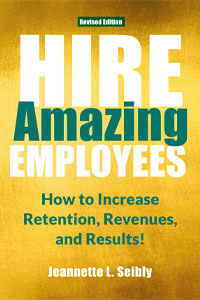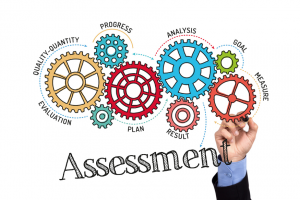
Many hiring managers believe relying on their instincts, and intuition/gut saves time and gives them all they need to make good hiring decisions. They think they’ll know the right candidate when they meet them.
Unfortunately, there are many problems with this belief. It creates:
- Unconscious bias
- Ghosting by job candidates and new hires
- Turnover of talent, loss of customers, and litigation (think money and reputation)
- Removal of a bad hire which can take up to 18 months (think again money and reputation)
- Bad company reputation when making decisions without factual data … (Remember, this job candidate could become a future customer or decision-maker for a sales contract or award.)
Be Clear! Your Goals During the Interview Are to Determine:
- Can the job candidate do the job?
- Will the job candidate do the job?
- Can the job candidate do the job in this company?
When you answer the above three questions in writing, you get real about the actual competencies required. Remember, business is changing, and so have business requirements.
- What actual competencies are required?
- What does the right candidate need to accomplish in 30-60-90-180 days?
- What job fit assessment is best to see the “whole person?”
Example, if you’re seeking a salesperson, does s/he need to generate leads, close, and provide good ongoing customer care?
Preparation is Critical for Effective Interviews
- Ask job-related questions (not about the latest book read, hobbies outside work, etc.)
- Create a structured interview with job-related questions
Review interview questions to ensure they do not create unconscious bias. Too often, we ask about recent books read, movies seen, and hobbies. These can get you in legal trouble. Why? You are inferring characteristics from their responses without factual data.
As you already know, stay away from questions about a candidate’s lifestyle, childcare, age, race, religion, etc.
Example, a hiring manager asked a candidate about the most recent book he’d read. He said, “Jaws.” She refused to talk with him further inferring he was an angry person. (Yes, this actually happened.)
Four Tips to Improve Your Interview and Selection Results
Note: Interviews should be only one-third of a well-designed strategic selection process. The other key parts include assessments (1/3) and due diligence (1/3). (Hire Amazing Employees)
1. Listen to their responses. Hear what they are saying. Don’t fill in the blanks with what you want to hear. Instead, ask questions for clarification before moving on to the next question.
2.Use Rule of 3 to determine the depth and breadth of job experience and skills.
An example of using the Rule of 3 to hire a project manager:
1) How do you handle team conflict? Can you give me an example?
2) What were the results?
3) If I talked with the team, how would they describe your leadership skills?
3. Ask about their coachability, how they handle mistakes, and flexibility with new assignments. Many will respond, “no problem.” Again, use the Rule of 3 to deep dive. You’ll hear their genuine willingness or unwillingness to answer these questions. Their core behaviors seldom change regardless of what they say.
4. Ask for examples. When asking job-related questions, always ask for examples. Example: Tell me about your working relationships with previous work teams, bosses, and customers.
Many years ago, I conducted a final interview with an experienced general manager for a business owner. I learned by asking for examples that each time she talked about her past three jobs, she expressed her upset with the business owners’ demanding ways. When I asked if she was aware of her upsets, she answered me honestly, “no.” I then shared that working with this business owner would be no different … he was very demanding too.
©Jeannette Seibly, 2021-2022 All Rights Reserved
 Jeannette Seibly is The Leadership Results Coach. She has been an award-winning international executive and family business management consultant, keynote speaker, and author for over 29 years. Her focus is to guide leaders to make a positive difference. Feel stuck moving your team forward? Want straightforward counsel on how to do it? Let’s chat! Contact Jeannette for a confidential conversation.
Jeannette Seibly is The Leadership Results Coach. She has been an award-winning international executive and family business management consultant, keynote speaker, and author for over 29 years. Her focus is to guide leaders to make a positive difference. Feel stuck moving your team forward? Want straightforward counsel on how to do it? Let’s chat! Contact Jeannette for a confidential conversation.
A note from Jeannette about using your interview time effectively: Many hiring managers rely too much on their intuition or gut, which leads to disastrous results: top talent and great customers leave, and the company’s bottom line looks grim. This week’s article covers the basics of conducting effective interviews. When done right, it saves time, money, and sleepless nights. Have questions? Most do! Let’s chat now!
 Are you asking good, job-related interview questions? When hiring new employees or rehiring former ones, ask about their ability to handle mistakes. Why? 90% of new hires fail because they dismiss coaching or advice about how to improve. Get your copy of the newly released, Hire Amazing Employees: How to Increase Retention, Revenues and Results! and suggested interview questions to get you started.
Are you asking good, job-related interview questions? When hiring new employees or rehiring former ones, ask about their ability to handle mistakes. Why? 90% of new hires fail because they dismiss coaching or advice about how to improve. Get your copy of the newly released, Hire Amazing Employees: How to Increase Retention, Revenues and Results! and suggested interview questions to get you started.


 Jeannette Seibly is The Leadership Results Coach. She has been an award-winning international executive and family business management consultant, keynote speaker, and author for over 29 years. Her focus is to guide leaders to make a positive difference. Feel stuck moving your team forward? Want straightforward counsel on how to do it? Let’s chat!
Jeannette Seibly is The Leadership Results Coach. She has been an award-winning international executive and family business management consultant, keynote speaker, and author for over 29 years. Her focus is to guide leaders to make a positive difference. Feel stuck moving your team forward? Want straightforward counsel on how to do it? Let’s chat!  Why do new hires leave so soon? There can be many reasons. But it’s often due to NO (or the poorly designed) new employee orientation and onboarding program! Be part of the 12% that onboards effectively! Want ideas to help you get started? Get your copy of the newly released,
Why do new hires leave so soon? There can be many reasons. But it’s often due to NO (or the poorly designed) new employee orientation and onboarding program! Be part of the 12% that onboards effectively! Want ideas to help you get started? Get your copy of the newly released, 






 Jeannette Seibly is The Leadership Results Coach. She has been an award-winning international executive and family business management consultant, keynote speaker, and author for over 29 years. Her focus is to guide leaders to make a positive difference. Feel stuck moving your team forward? Want straightforward counsel on how to do it? Let’s chat!
Jeannette Seibly is The Leadership Results Coach. She has been an award-winning international executive and family business management consultant, keynote speaker, and author for over 29 years. Her focus is to guide leaders to make a positive difference. Feel stuck moving your team forward? Want straightforward counsel on how to do it? Let’s chat! 